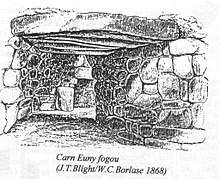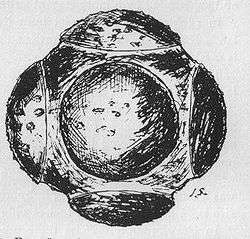Fogou
A fogou or fougou[1] (pronounced "foo-goo") is an underground, dry-stone structure found on Iron Age or Romano-British-defended settlement sites in Cornwall. The original purpose of a fogou is uncertain today. Colloquially called vugs, vows, foggos, giant holts, or fuggy holes in various dialects,[2] fogous have similarities with souterrains or earth-houses of northern Europe and particularly Scotland, including Orkney. Fewer than 15 confirmed fogous have been found.

Construction
Fogous consist of a buried, usually corbelled stone wall, tapering at the top and capped by stone slabs. They were mainly constructed by excavating a sloping trench about 5 ft (1.5 m) wide and 6 ft (1.8 m) deep, lining it with drystone walling as stated, which was battered inwards and roofed with flat slabs; soil from excavation was heaped on top as at Pendeen Vau or incorporated in the rampart of the enclosure as at Halliggye Fogou, Trelowarren.[3]
Function
The purpose of a fogou is no longer known. Their central location in settlements and the work that evidently went into constructing them is indicative of their importance to the community. It has been conjectured that they were used for religious purposes, as refuges, or for food storage. Many are oriented south-west-north-east, facing the prevailing wind.[3] Currently, both documentary and subsequent archaeological evidence support their use as refuges, possibly during raiding trips, as first suggested by Kenneth L MacGregor.[4] The alternative theory that they were used for food storage seems impractical given the damp conditions, while the theory of ritual use is unlikely given that the Celtic Druid tradition focused more on the living world. Nancy Edwards wrote that "evidence would support this: creeps, hidden chambers and sally ports, as well as the fact that most sonterrains were invisible above ground, would all have helped to provide protection in the case of sudden attack. They could, however, turn into death-traps if the aggression was prolonged."[5]
However, where they were open at both ends, a fogou could provide suitable conditions for food storage, especially the drying of meat or storage of dairy products such as milk, butter and cheese where natural moulds would assist in preservation of perishable foodstuffs.[6] Ashpits found at Trewardreva and in the circular side-chamber at Carn Euny were probably for preserving gulls' eggs, as was done on Saint Kilda in Scotland. A layer of black greasy mould with charcoal, animals and bird bones at Treveneague is also very suggestive of food storage. Diodorus Siculus stated that Iron Age people in Britain stored their grain in "underground repositories", adding contemporary evidence to the speculation that they were mainly used for food storage.[3] Excavated examples at Halliggye, Carn Euny and Boden suggest fogous may have been deliberately filled after use or upon abandonment of the associated settlements.
Etymology
The word may be related to the Cornish words fow (plural fowys) and/or gogow (plural gogowyow), both meaning "cave".[7] In the past, locals in Cornwall have called them "fuggy-holes" but this term is seldom used today.[8]
History and archaeology

One function of the souterrains of Gaul and early medieval Ireland is to hide in boltholes to escape detection by raiders. Fogous may have had a similar function to the underground kivas of the Puebloans.[9]
Other underground structures such as "earth houses" or souterrains have some similarities with fogous. An example of an excavated souterrain is the site at Rosal, Strathnaver, Sutherland. In this example no finds were made inside the structure and the roof may have been only partially covered with stones, a timber roof being present on part of it. It was suggested that souterrains could have been used as barns.[10] Fogous are often associated with dwellings such as Iron Age villages.
Petrospheres or "stone balls" have been found in souterrains and, as possible symbols of power within prehistoric society, this discovery suggest a use other than basic storage of food and resources.
Sites

Halliggye Fogou on the Trelowarren estate is generally accepted to be the largest[11] and best surviving fogou.
Other unspoiled fogous survive at Carn Euny,[12][13] Boleigh Fogou near Lamorna,[13] Pendeen Vau[13] and Trewardreva near Constantine, the last of which is known locally[14] as Pixie's Hall or Piskey Hall.[11]
Partially destroyed fogous exist at Chysauster,[13] which is in the care of English Heritage and which has been blocked up for safety; at Boden Vean near Manaccan and at Lower Boscaswell[13] close to Pendeen.
Evidence of possible former fogous can be found at Porthmeor;[13] at Higher Bodinar; at Castallack and at Treveneague.[15] Another was found during rescue excavations at Penhale Round[16] on the A30, the most easterly example, but this has since been destroyed.[17]
See also
- Petrosomatoglyph – A supposed image of parts of a human or animal body in rock symbolism
- Kiva – Room used by Anasazi for religious rituals and political meetings
- Erdstall – A type of tunnel found across Europe
- Castle Bloody – A prehistoric feature on the island of Shapinsay, Orkney, Scotland
References
- "Fogou - Merriam Webster".
- "Fogous - Order of Bards and Druids".
- Fox, Aileen (1973). South-West England 3500 BC – AD 600. Pub. David & Charles. ISBN 0-7153-6209-7. p. 178.
- MacGregor. K.L A Re-examination of the Cornish Fogou, University of Edinburgh 2004
- Edwards, Nancy (1996). The Archaeology of Early Medieval Ireland. Routledge. p. 30. ISBN 978-0415220002. Retrieved 9 May 2017.
- Prehistoric Cooking, Jacqui Wood, 2001
- CornishDictionary.org.uk - "cave"
- Meyn Mamvro – Ancient stones and sacred sites in Cornwall. ISSN 0966-5897. pp. 20–21.
- Sharp, Mick (1997). Holy Places of Celtic Britain. Pub. Blandford. ISBN 1-85079-315-8. p. 155.
- Proceedings of the Society of Antiquaries of Scotland, 1967–68. Vol.100. Pps. 114–118
- Cornovia, Ancient Sites of Cornwall and Scilly, Craig Weatherhill. Cornwall Books. ISBN 1-871060-31-1.
- Bord, Janet and Colin. (1973) Mysterious Britain. Pub. Garnstone. ISBN 0-85511-180-1. p. 105.
- Belerion, Ancient Sites of Land's End. Craig Weatherhill. Alison Hodge ISBN 0-906720-01-X
- Hippisley Coxe, Antony D. (1973). Haunted Britain. Pub. Hutchinson. ISBN 0-09-116540-7. p. 21.
- "Pastscape - Detailed Result: MONUMENT NO. 425010". www.pastscape.org.uk.
- PastScape: Penhale Round, Cornwall
- Earth Homes Now: Fogous
Bibliography
- May, Jo (1996). Fogou – A Journey into the Underworld. Gothic Image Publications. ISBN 0-906362-34-2.
- Rowe, Toni-maree (2005). Cornwall in prehistory. Tempus Publishing Limited. pp. 127–132. ISBN 0-7524-3440-3.
- Weatherhill, Craig (1985). Cornovia – Ancient Sites of Cornwall & Scilly. Cornwall Books. p. 135. ISBN 1-871060-31-1.
- Weatherhill, Craig (1981). Belerion – Ancient Sites of Land's End. Alison Hodge. p. 87. ISBN 0-906720-01-X.
- Cooke, Ian (1987). Journey to the Stones – Mermaid to the Merrymaid. p. 160. ISBN 0-9512371-1-X.